View in other NatureServe Network Field Guides
NatureServe
Montana
Utah
Wyoming
Idaho
Wisconsin
British Columbia
South Carolina
Yukon
California
New York
Missoula Phlox - Phlox missoulensis
Other Names:
Phlox kelseyi var. missoulensis, Phlox kelseyi ssp. missoulensis
State Rank Reason (see State Rank above)
Phlox missoulensis (Missoula Phlox) is a state endemic known from a small number of occurrences in Missoula County, Montana. Since 1944 Phlox missoulensis has been recognized as unique, and taxonomically classified as a species (Wherry 1944), variety (Cronquist 1959), or subspecies (Campbell 1992), and recently returned to species status (Locklear 2009). Since 1986, this plant has been classified as a Montana Species of Concern (Montana Natural Heritage Program (MTNHP) 1986).
As of 2024, the State’s occurrences are managed entirely or through partnership by the City of Missoula, Missoula County, Five Valleys Land Trust, and private landowners. Populations occur in areas used for public recreation, residential development, and road and utility service corridors (MTNHP 2024). At all known occurrences, populations face on-going threats from habitat encroachment, noxious weed invasion, trampling, and mortality from ground disturbing activities. Other potential threats to the plants or its habitat include fire suppression, excessive dog waste accumulation, and improperly timed or applied herbicide treatments. On-going monitoring by Missoula Parks and Recreation is helping to assess and mitigate the impacts of these threats. Conservation projects with the City of Missoula, Missoula County, land trusts, and private landowners are helping to conserve land for multiple purposes, including the protection of Phlox missoulensis. Continued implementation of land conservation practices and monitoring that evaluates these efforts are needed to track the long-term status and population trends of Phlox missoulensis.
General Description
PLANTS: A tap-rooted, perennial plant that forms low, dense mats or cushions. Numerous, branched stems are pubescent, often glandular, and grow prostrate to ascending, 2-10 cm tall. Taproots are stout and woody. Sources: Giblin et al. [eds.] 2018; Lesica et al. 2022.
LEAVES: Simple, sessile leaves are arranged opposite on the stem. Main stem leaves (not axillary fascicles) are linear (parallel margins) in shape, firm to rigid, 10-25mm long and about 1 mm wide. Full length of leaf margins are ciliate, often stiffly. Axillary fascicles of small leaves are common. Sources: Giblin et al. [eds.] 2018; Lesica et al. 2022.
INFLORESCENCE: White to bluish flowers grow singularly at the tips of branches. Calyx: 5 sepals connected by a hyaline intercostal membrane that is narrower than the thickened herbaceous portion of the calyx lobe base; glandular-villous (long, soft, crooked, and unmatted) hairs; and 6-12 mm long. Corolla: 5 petals, each a slender tube and lobe forming a right angle (salverform); tube 9-15 mm long; lobes 5-6 mm long. Pistil: Style (3)4-5(7) mm long. Sources: Giblin et al. [eds.] 2018; Lesica et al. 2022.
Phlox is a direct transliteration of the Greek word for flame, referring to the bright flowers (Cronquist 1959). The specific epithet of missoulensis references the Type location of Missoula, Montana.
Phenology
Missoula Phlox typically flowers from about mid-April to June. However, flowering from September to October has been seen by a small percentage of plants at one population (Johnson personal communication).
Diagnostic Characteristics
The low growing
Phlox species are taxonomically challenging to identify. A technical botanical key and examination of herbarium specimens should be used to positively identify species. Below are diagnostic characteristics for
Phlox missoulensis and
some of its look-alikes:
Missoula Phlox -
Phlox missoulensis, SOC
* Plants: Pubescent with gland-tipped hairs – at least on the calyx. Tendency to form alpine-like cushions.
* Leaves: Not succulent; firm to rigid; dark green. Greater than half of the leaf margin is ciliate.
* Flowers: White to blue, singular on stem.
* Calyx: Intercostal membrane is
narrower than the thickened herbaceous portion of the calyx lobe base.
* Style: 4.0-7.5 mm long.
* Habitat: Upland habitats; stoney soil on ridges in valleys.
* Global Distribution: Missoula County (narrow endemic).
Kelsey’s Phlox -
Phlox kelseyi* Plants: Glabrous (without hairs) to pubescent or glandular-pubescent. Tendency to form spreading clumps.
* Leaves: Succulent, more or less; pale green. The portion of the leaf margin that is ciliate is highly variable.
* Flowers: White, singular on stem.
* Calyx: Glabrate to glandular-villous, often ciliate. Glabrous to pubescent or glandular-pubescent. Flat intercostal membranes.
* Style: 4.0-7.5 mm long.
* Habitat: Wetlands, moist meadows, vernally moist alkaline meadows, alkaline flats, or near hot springs in valleys to montane zones of Montana.
* Montana’s Distribution: West-central and Carbon County.
Many-flowered Phlox -
Phlox multiflora* Stems: lacks hairs (glabrous) below, villous and glandular above.
* Leaves: Not succulent, but pliable. Linear in shape
and minutely scabrous – sometimes sparsely villous.
* Flowers: Generally white or pale bluish, 1-3 per stem.
* Calyx: Tube glabrous or occasionally pubescent. Flat intercostal membranes.
* Habitat: Sagebrush steppe, grasslands, open forests in the montane to lower alpine zones.
* Montana’s Distribution: Southwest, South-central, and Flathead County.
Spreading Phlox -
Phlox diffusa* Leaves: Not succulent, but firm. Linear in shape, glabrous or weakly scaberulous, ciliate, and 5-15 mm long.
* Flowers: Pink, blue-purple, or white, 1 per stem.
* Calyx: villous, especially on tube, or very rarely eglandular-pubescent or glabrous. 5-9 mm long. Flat intercostal membranes.
* Habitat: Stony, non-calcareous fellfields, open slopes, forest openings, and rock outcrops in the upper montane to alpine zones.
TAXONOMY & NOMENCLATUREPhlox missoulensis was recognized as a distinct species by Wherry based on a specimen collected on Waterworks Hill in Missoula, Montana by Merton J. Reed on April 28, 1932 (Holotype: Philadelphia Herbarium (PH), 45730) (Wherry 1944; Locklear 2009). Cronquist (1959) reduced this distinction to a variety, recognizing varieties
missoulensis and
kelseyi in
Vascular Plants of the Pacific Northwest (1959). Wherry (1962 and 1965) strongly disagreed. Campbell (1992) examined the three varieties of
Phlox kelseyi in her graduate studies on the
Biosystematics of Phlox kelseyi (Polemoniaceae): missoulensis, kelseyi, and salina. Among these three varieties, Campbell found differences in ten morphological characters but statistically could not discern complete distinctions. Between varieties
kelseyi and
missoulensis Campbell also found differences in habit and habitat. Campbell concluded that all three varieties are better described as subspecies, but she never published her recommendations in the scientific literature. In 2009, Locklear published an updated circumscription that recognized
Phlox missoulensis (Locklear 2009).
Botanists have also debated the identification of herbarium specimens collected from places between Missoula and Meagher Counties in Montana. According to Lesica in
Manual of Montana Vascular Plants (2022) these specimens have leaves that appear intermediate between
Phlox missoulensis and
P. pulvinata. In a floristic review of the Family Polemoniaceae for the forthcoming
Flora of North America (FNA) Volume 15, authors Ferguson, Mayfield, and Patterson are revising the
Phlox treatment. Herbarium specimens previously identified as
Phlox kelseyi subspecies or variety
missoulensis from Missoula County were re-determined to be
Phlox missoulensis while most (not all) specimens from places east to Meagher County were determined as
Phlox condensata in 2016 by Mayfield and Ferguson; refer to digital MONTU specimen data at the
Consortium of Pacific Northwest Herbaria portal. The MTNHP considers
Phlox missoulensis to be endemic to Missoula County and defers to the University of Montana Herbarium (MONTU) for identification expertise.
Species Range
Montana Range
Range Descriptions
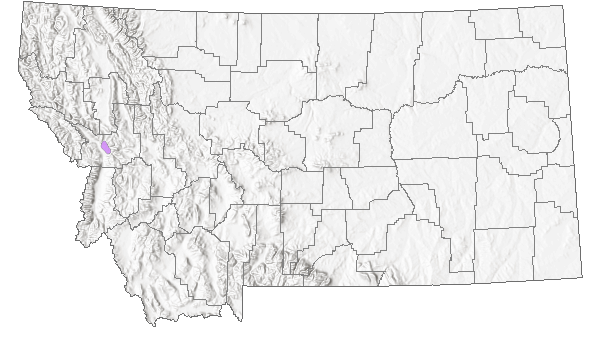
 Native
Native
Range Comments
Missoula Phlox is a narrow endemic plant. Globally, it is only known to occur in Missoula County, Montana. The first documented collection of Missoula Phlox was made by Morton J. Elrod on May 27, 1897 (MONTU 21749).
See also subsection, TAXONOMY & NOMENCLATURE.
Observations in Montana Natural Heritage Program Database
Number of Observations: 288
(Click on the following maps and charts to see full sized version)
Map Help and Descriptions
Relative Density

Recency
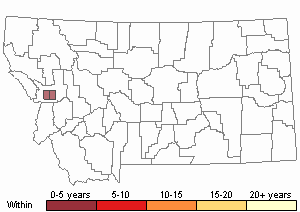
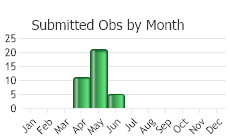
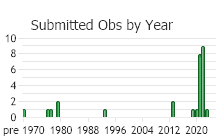
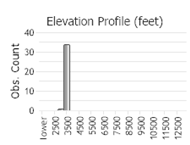 (Observations spanning multiple months or years are excluded from time charts)
(Observations spanning multiple months or years are excluded from time charts)
Habitat
Missoula Phlox grows in grasslands on dry, stony to shallow soils on exposed mountain slopes and ridges in the valley zones of Missoula County, Montana (Locklear 2009; Lesica et al. 2022).
In general region, cushion plant habitat is more extensive than where Missoula Phlox has been found. Missoula Phlox populations have been found below the Glacial Lake Missoula high water line and on the North Hills of Missoula along the east-west pathway of the Hellgate Winds (Johnson personal communication). It is hypothesized that these abiotic conditions support the species' life requirements.
National Vegetation Classification System Groups Associated with this Species
Grassland
Lowland - Prairie Grassland
Ecology
POLLINATORS
Flies, of a few different species, are dominant pollinators of Missoula Phlox (Johnson personal communication). Various bumblebee (Bombus) species have also been observed visiting Missoula Phlox (Johnson personal communication).
The following animal species have been reported as pollinators of Phlox species: Bombus vagans, Bombus flavifrons, Bombus melanopygus, Bombus pensylvanicus, Bombus bimaculatus, Bombus griseocollis, Bombus impatiens, and Bombus kirbiellus (Shaw and Taylor 1986, Colla and Dumesh 2010).
Reproductive Characteristics
Plants reproduce by seed.
FLOWERING
Based on numerous observations of Missoula Phlox in natural and greenhouse environments, Missoula Phlox exhibits a tremendous range or large variation in its flowering period. It is hypothesized that the large variation in phenology may be an adaptation to its harsh environment (Johnson personal communication). Plants typically flower in spring, but individuals may flower in the fall. Observations in 2023 found that 1-5% at the Bluebird Preserve population flowered from September to October (Johnson personal communication). These individuals had not previously flowered in the spring or summer because they showed no remnant structure of an inflorescence, fruit or flower. In the greenhouse, containerized plants grown from seed flowered in February to March during two different years (Johnson personal communication). These containerized plants had been completely exposed to the harsh winter/spring conditions that existed outside of the greenhouse. It was estimated that 1-3% of the greenhouse population exhibited this early flowering. Although greenhouse conditions typically do not replicate natural environments, the observations suggest that Missoula Phlox has a broader width of phenotypical variation than previously assumed.
Management
Missoula Phlox is a conspicuous cushion-forming plant that can retain abundant populations and persist in Missoula City with concerted management and conservation practices.
TRAIL MONITORINGThe population trend of invasive and native indicator plant species in cushion plant communities on Waterworks Hill in Missoula, Montana is being studied (Lesica and Clark Fork Chapter, Montana Native Plant Society 2022).
Plots were placed in two portions of a trail, named Waterworks-West and Waterworks-East. From 2007 to 2022 the percent frequency of plant species fluctuated annually, but the overall trend differed by habit:
Waterworks-East plots: The overall trend was stable for one native broad-leaved forb (Silvery Groundsel) and two noxious weeds (Dalmatian Toadflax, Sulphur Cinquefoil); declined for two native broad-leaved forbs (Mountain Douglasia, Alberta Penstemon) and one noxious weed (Spotted Knapweed); and increased for one grass (Bluebunch Wheatgrass) and one native broad-leaved forb (Missoula Phlox).
Waterworks-West plots: The overall trend was stable for one grass (Sandberg’s Bluegrass); declined for four noxious weeds (Spotted Knapweed, Leafy Spurge, Dalmatian Toadflax, Sulphur Cinquefoil); and declined for three native broad-leaved forbs (Silver Buckwheat, Mountain Douglasia, Missoula Phlox).
The 2022 progress report summarized that:
* Missoula Phlox increased at Waterworks-East where the trail segment had been closed prior to 2007, and decreased in Waterworks-West where the trail segment remained open.
* On the closed trail, Missoula phlox increased from 0 to 3 plants between 2007 and 2022 across a total of 15, 100x100cm microplots. Bluebunch Wheatgrass also increased substantially on the closed trail.
* The decline of Missoula Phlox in the Waterworks-West plots was no greater near to the trail than.
* Overall native species fared better than the noxious weeds. The most significant declines occurred between 2007 and 2009 in which July 2007 was Missoula’s hottest July. It was presumed that weeds that are well-adapted to Missoula’s average climate on typical grassland soils, may not be as well adapted as native species during extreme drought events (Pearson et al. 2017).
TRAIL MANAGEMENTTrails have gradually widened where people avoid wet, muddy, and/or icy surfaces, resulting in Missoula Phlox plants being trampled or killed. To encourage people to stay on the existing trails, land managers have lined the trails with small boulders. This has resulted in unforeseen circumstances in which boulders create a new microsite that is conducive to noxious weed establishment. Thus, walking on the established trail system and avoiding trails when wet or icy has shown to help protect plants and habitat.
Learn more about trail etiquette and how to use, share, and protect Missoula’s Open Space from the
City of Missoula’s Visitor Information webpage.
COLONIZATION OF DISTURBED GROUNDMissoula Phlox occupies native, undisturbed cushion plant communities. As far back as 1948 potential manmade disturbances to its habitat, such as a gravel-digging operation, have been documented (Wherry 1955). Gravel pit mining has taken place in at least one area where Missoula Phlox occurs. Surveys conducted in the early 2000s have discovered that Missoula Phlox has re-colonized some of these disturbed areas (Johnson person communication). Although plants and habitat were historically disturbed, these quarries still have some intact soils and decades of environmental rest. Under these conditions, Missoula Phlox has shown its ability to re-establish disturbed ground.
Stewardship Responsibility
Threats or Limiting Factors
STATE THREAT SCORE REASON
Reported threats to Montana's populations of Missoula Phlox include residential and recreational trail development, recreation use of trails and roads, utility and service line activities (MTNHP 2024). Potential threats include improperly applied herbicide applications and fire suppression (MTNHP 2024). An overall State Threat Score of “high to very high” is assigned to Missoula Phlox based on the following factors:
Residential Development: On-going development occurs in known and potential habitat for Missoula Phlox.
Recreation: A network of trails bisects populations of Missoula Phlox. Where new trails are developed some removal and trampling of plants have occurred. Over the years, the number of people that use the trails for walking and occasionally , biking, and running have increased, along with the number of annual days used. Some of the trails have gradually widened where people naturally walk around areas that are wet and/or icy. Widening of trails has resulted in plants being trampled and killed. Along popular trails the accumulation of dog waste is posing a potential threat by fertilizing the habitat, which could alter soil properties.
Transportation: Dirt roads bisect some populations. Plants on and along the roads have been trampled by vehicles.
Non-Native Plants: Noxious plant populations pose the most significant threat because they can compete with Missoula Phlox for water, nutrients, and/or modify the habitat. Noxious weeds that contribute to put the persistence of Missoula Phlox at-risk include: Dalmatian Toadflax (Linaria dalmatica), Spotted Knapweed (Centaurea stoebe), Leafy Spurge (Euphorbia virgata), and Sulphur Cinquefoil (Potentilla recta).
Ground-disturbing Activities: Missoula Phlox plants and habitat have been dug up and/or trampled through un-mitigated ground disturbing activities by utility companies performing maintenance work and by vandals (Kidston 2015).
Fire Suppression: Low-intensity fires have naturally maintained the quality of habitat for cushion plant communities. Fire suppression has removed natural fires from the landscape.
References
- Literature Cited AboveLegend:
 View Online Publication
View Online Publication Campbell, L.M. 1992. Biosystematics of Phlox kelseyi (Polemoniaceae). M.S. thesis. University of Montana. 78 pp.
Campbell, L.M. 1992. Biosystematics of Phlox kelseyi (Polemoniaceae). M.S. thesis. University of Montana. 78 pp. Colla, S.R. and S. Dumesh. 2010. The bumble bees of southern Ontario: notes on natural history and distribution. Journal of the Entomological Society of Ontario 141:39-68.
Colla, S.R. and S. Dumesh. 2010. The bumble bees of southern Ontario: notes on natural history and distribution. Journal of the Entomological Society of Ontario 141:39-68. Cronquist, Arthur. 1959. Phlox In: Vascular Plants of the Pacific Northwest. C.L. Hitchcock, A. Cronquist, M. Ownbey, and J.W. Thompson, eds. University of Washington Press, Seattle, Washington. Pp. 124-137.
Cronquist, Arthur. 1959. Phlox In: Vascular Plants of the Pacific Northwest. C.L. Hitchcock, A. Cronquist, M. Ownbey, and J.W. Thompson, eds. University of Washington Press, Seattle, Washington. Pp. 124-137. Hitchcock, C.L. and A. Cronquist. 2018. Flora of the Pacific Northwest: An Illustrated Manual. Second Edition. Giblin, D.E., B.S. Legler, P.F. Zika, and R.G. Olmstead (eds). Seattle, WA: University of Washington Press in Association with Burke Museum of Natural History and Culture. 882 p.
Hitchcock, C.L. and A. Cronquist. 2018. Flora of the Pacific Northwest: An Illustrated Manual. Second Edition. Giblin, D.E., B.S. Legler, P.F. Zika, and R.G. Olmstead (eds). Seattle, WA: University of Washington Press in Association with Burke Museum of Natural History and Culture. 882 p. Johnson, G. 2024. Observational information on Phlox missoulensis. January to December electronic mail correspondence between Research and Monitoring Program Supervisor, Missoula Parks and Recreation, Missoula, Montana and MTNHP Botanist, Helena, Montana.
Johnson, G. 2024. Observational information on Phlox missoulensis. January to December electronic mail correspondence between Research and Monitoring Program Supervisor, Missoula Parks and Recreation, Missoula, Montana and MTNHP Botanist, Helena, Montana. Kidston, Martin. 2015.Vandals Chop Up Rare Plant To Dig Missoula Peace Sign. March 9. online newspaper. Missoulian, Missoula, Montana.
Kidston, Martin. 2015.Vandals Chop Up Rare Plant To Dig Missoula Peace Sign. March 9. online newspaper. Missoulian, Missoula, Montana. Lesica, Peter and Clark Fork Chapter, Montana Native Plant Society (CFC, MNPS). 2022. July. Monitoring Trend of Invasive Species and Native Indicator Species in Cushion Plant Communities on Waterworks Hill and Mount Jumbo, Missoula County, 2022 Progress Report. Prepared by Lesica and CFC, MNPS, Missoula, Montana. Prepared for Department of Parks and Recreation, Missoula, Montana.
Lesica, Peter and Clark Fork Chapter, Montana Native Plant Society (CFC, MNPS). 2022. July. Monitoring Trend of Invasive Species and Native Indicator Species in Cushion Plant Communities on Waterworks Hill and Mount Jumbo, Missoula County, 2022 Progress Report. Prepared by Lesica and CFC, MNPS, Missoula, Montana. Prepared for Department of Parks and Recreation, Missoula, Montana. Locklear, James H. 2011. Phlox, A Natural History and Gardner's Guide. Timber Press, Inc. Portland and London.
Locklear, James H. 2011. Phlox, A Natural History and Gardner's Guide. Timber Press, Inc. Portland and London. Montana Natural Heritage Program (MTNHP). 2024. Threat Ranking Assessment for Phlox missoulensis. November-December. Botany Program, MTNHP, Helena, Montana.
Montana Natural Heritage Program (MTNHP). 2024. Threat Ranking Assessment for Phlox missoulensis. November-December. Botany Program, MTNHP, Helena, Montana. Montana Natural Heritage Program. 1986b. Montana plant species of concern, June 1986. Helena, Mont: Montana Natural Heritage Program.
Montana Natural Heritage Program. 1986b. Montana plant species of concern, June 1986. Helena, Mont: Montana Natural Heritage Program. Pearson, D.E., Y.K. Ortega, and J.L. Maron. 2017. The tortoise and the hare: reducing resource availability shifts competitive balance between plant species. Journal of Ecology 105:999-1009.
Pearson, D.E., Y.K. Ortega, and J.L. Maron. 2017. The tortoise and the hare: reducing resource availability shifts competitive balance between plant species. Journal of Ecology 105:999-1009. Shaw, D.C. and R.J. Taylor.1986. Pollination ecology of an alpine fell-field community in the North Cascades. Northwest Science 60:21-31.
Shaw, D.C. and R.J. Taylor.1986. Pollination ecology of an alpine fell-field community in the North Cascades. Northwest Science 60:21-31. Wheery, Edgar T. 1962. A controversial treatment of the Polemoniaceae. Madrono 16:270-271.
Wheery, Edgar T. 1962. A controversial treatment of the Polemoniaceae. Madrono 16:270-271. Wherry, E.T. 1944. New phloxes from the Rocky Mountains and neighboring regions. Notulae Naturae 146: 1-11.
Wherry, E.T. 1944. New phloxes from the Rocky Mountains and neighboring regions. Notulae Naturae 146: 1-11. Wherry, Edgar T. 1955. The Genus Phlox. Morris Arboretum Monographs III. Morris Arboretum of the University of Pennsylvania, Philadelphia, Pennsylvania. Wickersham Printing Company Lancaster, Pennsylvania.
Wherry, Edgar T. 1955. The Genus Phlox. Morris Arboretum Monographs III. Morris Arboretum of the University of Pennsylvania, Philadelphia, Pennsylvania. Wickersham Printing Company Lancaster, Pennsylvania. Wherry, Edgar T. 1965. The genus Phlox, ten years after. Bartonia 35:13-16.
Wherry, Edgar T. 1965. The genus Phlox, ten years after. Bartonia 35:13-16.
- Additional ReferencesLegend:
 View Online Publication
View Online Publication
Do you know of a citation we're missing? Heidel, B. 2001. Montana plant species of special concern June 2001. Montana Natural Heritage Program. Helena, MT. 38pp.
Heidel, B. 2001. Montana plant species of special concern June 2001. Montana Natural Heritage Program. Helena, MT. 38pp. Lackschewitz, K. 1991. Vascular plants of west-central Montana--identification guidebook. U.S. Forest Service Intermountain Research Station, Ogden, UT. 648 pp.
Lackschewitz, K. 1991. Vascular plants of west-central Montana--identification guidebook. U.S. Forest Service Intermountain Research Station, Ogden, UT. 648 pp. Lesica, P., M.T. Lavin, and P.F. Stickney. 2012. Manual of Montana Vascular Plants. Fort Worth, TX: BRIT Press. viii + 771 p.
Lesica, P., M.T. Lavin, and P.F. Stickney. 2012. Manual of Montana Vascular Plants. Fort Worth, TX: BRIT Press. viii + 771 p. Lesica, P., M.T. Lavin, and P.F. Stickney. 2022. Manual of Montana Vascular Plants, Second Edition. Fort Worth, TX: BRIT Press. viii + 779 p.
Lesica, P., M.T. Lavin, and P.F. Stickney. 2022. Manual of Montana Vascular Plants, Second Edition. Fort Worth, TX: BRIT Press. viii + 779 p. Locklear, James H. 2009. Nomenclatural innovations in Phlox (Polemoniaceae), with updated circumscription of P. caespitosa, P. douglasii, P. missoulensis, and P. richardsonii. Journal of the Botanical Research Institute of Texas 3:645-658.
Locklear, James H. 2009. Nomenclatural innovations in Phlox (Polemoniaceae), with updated circumscription of P. caespitosa, P. douglasii, P. missoulensis, and P. richardsonii. Journal of the Botanical Research Institute of Texas 3:645-658. Schassberger, L.A. and P.L. Achuff. 1991. Status review of Phlox kelseyi var. Missoulensis. Prepared for the USDA Forest Service, Region 1, Lewis & Clark National Forest, Montana. Montana Natural Heritage Program, Helena, MT 37 pp.
Schassberger, L.A. and P.L. Achuff. 1991. Status review of Phlox kelseyi var. Missoulensis. Prepared for the USDA Forest Service, Region 1, Lewis & Clark National Forest, Montana. Montana Natural Heritage Program, Helena, MT 37 pp. Wherry ET. 1969. Phlox and Polemonium (Polemoniaceae) in the intermountain region. SIDA 3(6). pp441-444.
Wherry ET. 1969. Phlox and Polemonium (Polemoniaceae) in the intermountain region. SIDA 3(6). pp441-444.
- Web Search Engines for Articles on "Missoula Phlox"





